Recently, while researching the do’s and don’ts of choosing a wedding photographer for a possible blog article, I happened across a line in a magazine article that really got me thinking.
It was a caption under a wedding photo and it read: “Your wedding photos are the only tangible items that remain at the end of the day and become even more priceless as each year goes by so you’ll want to take your time choosing your wedding photographer.”
I don’t disagree with the idea of photos becoming more precious as time goes by, but as for them being the only tangible items you take away from your wedding day, that’s a bit of a stretch.
What about the person you just married? What about the wedding gifts? And what about the rings?
While “I do” and signing the marriage certificate rate right up there in terms of big moments on your wedding day, symbolically, exchanging wedding rings is the thing that really seals the deal.
Apart from perhaps a wedding photo in your wallet, the one thing that will stay with you almost every moment of every day after you’re married is your wedding ring.
To my mind, that makes them pretty special – and maybe they deserve just as much care and attention as devoted to the engagement ring?
Attitudes are changing
One trend we’ve noticed over the past twelve or thirteen years is a little more ‘equality’ and more connectedness when it comes to couples choosing their wedding rings.
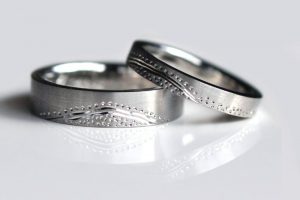
This pair of handmade matched platinum wedding bands feature original, aboriginal art-inspired engraving on a wire-brush finished band.
Of course, same sex marriage and recognition of things like non-binary genders have added a new dimension to the wedding industry, but go back a few decades and let’s face it, wedding rings were largely just functional. Little more than an ‘I’m married’ signpost – especially for ‘him’.
While that’s still true to some extent, these days we’re seeing many couples becoming much more creative in their designs and decisions about the all-important wedding rings.
Sometimes that means the rings are designed to obviously match one another. And sometimes the bride and groom take the opportunity to express their individuality.
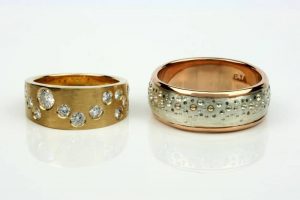
Each of this pair of wedding bands was created by one for the other. Hers is a tapered 18 carat recycled gold band with recycled diamonds in a Gemini constellation pattern. And for him (a keen surfer) recycled 18 carat rose gold with a recycled silver sleeve embossed with a bubble pattern.
Sometimes too our customers will design their wedding rings for each other in ‘secret’ – a very real expression of love and trust.
Whichever is right for you, shopping for, and designing your wedding rings opens up a world of possibilities.
Taking the time to create something special and meaningful now means that every time you glance down at your wedding finger, the band of metal resting there will remind you not just of that wonderful day, but also of your partner and all the other things that make your relationship special.
Our top 5 tips for designing your wedding rings
1) Make ethical choices
Of course, being an ethical jewellery business, we think the ethics behind the items you buy should be at the top of your list.
In the jewellery world, that means minimising the harm your purchase does to people and the planet and spending your money where it delivers the most benefit to those in need.
There are all kinds of serious environmental and human rights issues at stake in the global jewellery industry. Everything from slavery and exploitation to habitat destruction and mercury poisoning, from conflict funding and money laundering to avoidable carbon emissions.
If these things are of concern to you – and we really hope they are – then the good news is you can make choices that align with the things that matter to you.
Fair Trade options, recycling and upcycling, laboratory-created and vintage and pre-loved diamonds and gemstones are all easily available to you when you choose a jewellery company that cares about these things too.
It’s really not that hard to make responsible choices and the even better news is, in the fine jewellery world, ethically sourced materials are often no more expensive than their questionable counterparts.
2) Choose the metal carefully
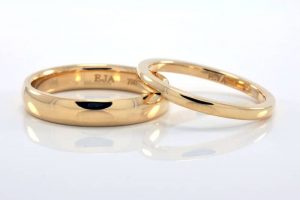
This pair of 18 carat recycled yellow gold wedding rings are beautiful in their simplicity.
Setting aside colour for a moment, there are two key things to consider when choosing the precious metal your ring will be made out of.
The first is: will you be wearing another ring with the one you’re about to buy? If so, to minimise erosion of either the new or existing piece, make sure both are made of the same metal – gold with gold, platinum with platinum, palladium with palladium.
Wedding Rings – a brief summary of a long history
In the jewellery world, an enormous amount of attention is devoted to the design and promotion of all things ‘engagement ring’, but engagement rings are a relative late comer when it comes to the practice of marriage.
The concept of an ‘engagement ring’ didn’t appear until the 13th century when Pope Innocent III instituted a waiting period between betrothal and marriage. Wedding rings however, pre-date the idea of an engagement ring by several thousand years.
Academic opinions differ, but it’s commonly thought that the practice of placing a ring on the finger of one’s ‘wife’ evolved from prehistoric times whereby the ‘groom’ would bind his intended’s hands and feet to keep her with him. As he became sure she would not run away, the bonds were gradually freed until they were replaced with a simple ring on the finger to remind its wearer of ‘ownership’. (This may explain the idea behind ‘tying the knot’.) Another version of this binding practice is that it was a pagan tradition intended to contain the bride’s ‘spirit’.
From a ceremony perspective, it’s the ancient Egyptians who are credited with the genesis of wedding band exchanges – from about 4,800BC. They fashioned theirs out of reeds.
In Anglo Saxon times rings made from hemp were given to the bride to signify a union. These ‘beweddings’ were not a formalised event. Usually an agreement was reached between the groom and the bride’s father and the union was signalled to the community by means of a feast or celebration of some kind. The Romans made their rings from iron.
The first rings made of precious metals were given to represent part of the ‘bride price’ – the sum of money or equivalent paid by the groom to the bride’s father for her ‘hand’.
In short, wedding rings started out (unfortunately) signifying ownership. In time they came to be more representative of a financial contract. These days, gladly, they’re much more a symbol of mutual commitment
Mixing metals can result in one wearing away a lot faster than it otherwise would because of their differing hardness.
And the second thing is: do you have sensitive skin that might react to alloys in your metal of choice? The most frequent offender when it comes to adverse skin reactions is nickel, which is commonly alloyed in white gold.
Nickel-free white gold is readily available so, if in doubt, check.
3) Your lifestyle and occupation should inform the design and choice of materials
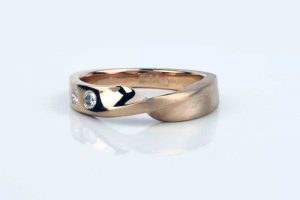
This unique handmade wedder features a Möbius twist, hammer set recycled diamonds and a half polished, half wire-brushed finish.
In terms of lifestyle and occupation informing design and materials, what we’re mostly thinking about here is the risk of damage to the ring and its elements.
For instance, highly polished rings are going to show scratches and scuffs much more than, say, one with a wire-brushed, beaten or engraved finish. So, if you expect you’ll be wearing your wedding ring while working in the garden or with building materials, a polished finish is probably not the way to go.
In the same vein, gold is softer than platinum and will get bent out of shape, dented, scratched and worn away more easily. So if you work with your hands, platinum is a good choice.
Likewise, if you plan to set gemstones or diamonds in your wedding ring, some gem types are relatively fragile and easily damaged and might best be avoided.
If the world of health care we know that palladium and gold do not react well to many clinical hand cleaning products, so platinum should again be your metal of choice. And while on the subject of cleanliness, rings with gems set into them are much harder to keep really clean because of the little nooks and crannies that are necessarily part of the make.
4) Don’t be afraid to express yourself
There is absolutely nothing wrong with having a plain, unadorned wedding ring. There is a lot of beauty in simplicity.
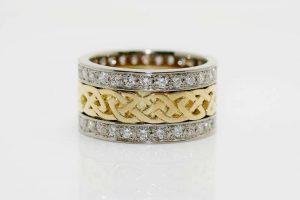
This stunning wedding ring is all one piece and features two Argyle diamond set eternity-style bands in 18 carat recycled white gold either side of a 18 carat recycled yellow gold band pierced in a Celtic knot pattern.
That said, wedding rings offer a wonderful opportunity to express your creativity and communicate something unique about you, your partner and your relationship.
Of course, if you want your wedding ring to complement your engagement ring, then that will determine many of the design options. But if you don’t really have to link the design of your wedding ring to any other piece of jewellery, then the sky’s the limit.
Wedding rings offer a wonderful palette for textures and finishes, piercing, two- or three- tone metal colours, gem and diamond setting and engraving – many of which can be combined in the one design.
Just be aware that, generally, the more complicated the design the more expensive the make will be – because of the labour required.
Also, always keep comfort in mind. Pointy, sharp and rough edges and surfaces might wind up being uncomfortable to wear all the time. They can also scratch other people’s skin (small children and partner’s during sleep come to mind). Plus, if your design makes it easy for detergents, hand creams, grime and other contaminants to get caught between your skin and the ring, you might find yourself with a very unpleasant skin irritation.
5) Give yourself enough time
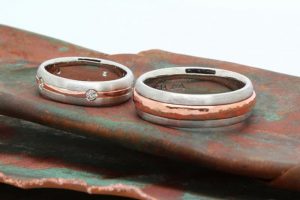
This pair of wire-brush finished, platinum wedding rings incorporate a very special reminder of the couple’s travels. The copper for the band around the middle of each ring was upcycled from some salvage acquired on a once-in-a-lifetime trip. Hers also features six hammer set Argyle diamonds evenly spaced around the ring.
Whilst you can sometimes buy a wedding ring off-the-shelf, more often than not they’re made to order – either by hand-making or machine pressing.
Either way there’ll normally be a delay between when you place your order and when your ring/s will be ready.
If the design is simple and the manufacturing jeweller isn’t busy, then you might only have to wait a week or so. But as soon as you start adding details like fitting your ring to an engagement ring, adding textured finishes, gem setting, engraving and the like, the whole process slows down – especially when it’s a custom design.
For a handmade, custom-designed ring, we’d normally suggest you allow 5-6 weeks turn around once the design has been signed off.
To learn more …
Visit our website to learn more about our wedding ring design and make service.
Ethical Jewellery Australia specialises in creating engagement and wedding rings that are as environmentally and socially responsible as we can make them. Every ring we produce is designed one-on-one with our customers and we would be delighted to help you design yours and make it for you.
Drop us a line at [email protected] if you’d like us to help you create a ring or rings you and your partner will love.
About EJA
Ethical Jewellery Australia is an online engagement, wedding ring and bespoke jewellery specialist. Every piece we do is custom designed and made to order (with the exception of simple wedding and commitment rings that are offered in a range of simple, popular designs).
We take our customers through the whole process from design to sourcing and finally to manufacturing.
All rings are handmade in Australia with recycled metals. (We can also supply Fair Trade gold if requested.)
Likewise, we only every use ethically sourced diamonds and gemstones. You can choose from Argyle, recycled, vintage and lab-grown diamonds, Australian, US, Fair Trade, recycled and lab-grown coloured gemstones.
By the way, we offer an Australia-wide service.
About the Author: Benn Harvey-Walker
 Benn is a Co-founder of Ethical Jewellery Australia and a keen student of ethical and sustainability issues in the jewellery world. He has a long history in sales and marketing and began working with EJA full time in early 2018.
Benn is a Co-founder of Ethical Jewellery Australia and a keen student of ethical and sustainability issues in the jewellery world. He has a long history in sales and marketing and began working with EJA full time in early 2018.
Benn co-authored the original Engagement Ring Design Guide in 2014 and edited the 2nd Edition in 2018. He is also the principal author of our Wedding and Commitment Ring Design Guide.
His main responsibilities at EJA are business development and sales process management. Benn also creates technical drawings for our ring designs.

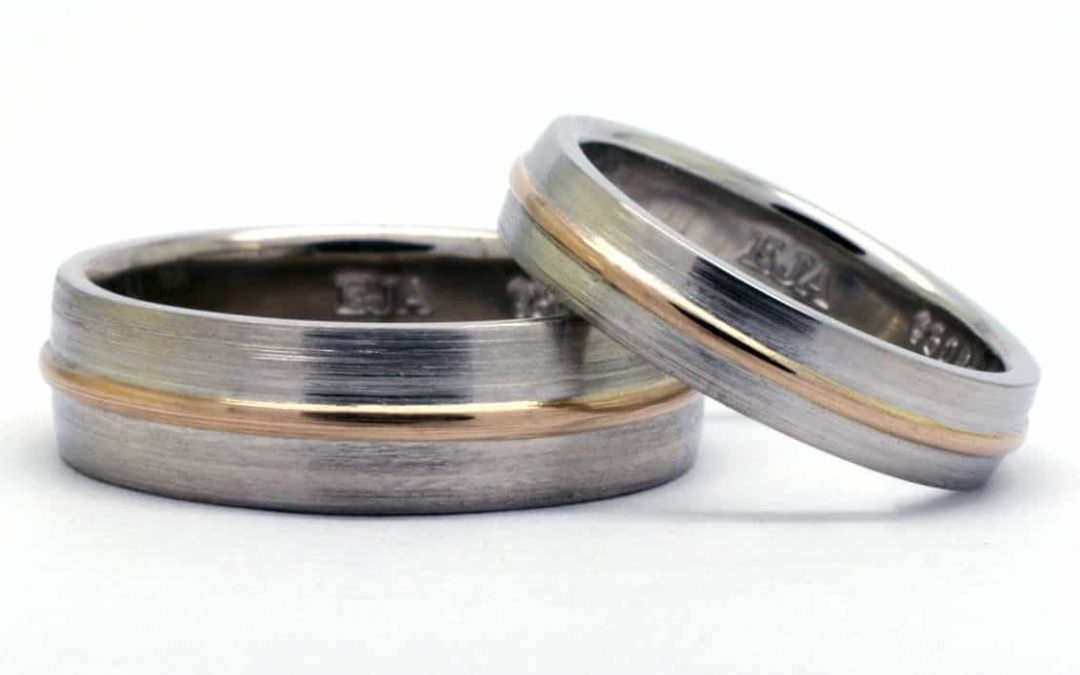
Recent Comments